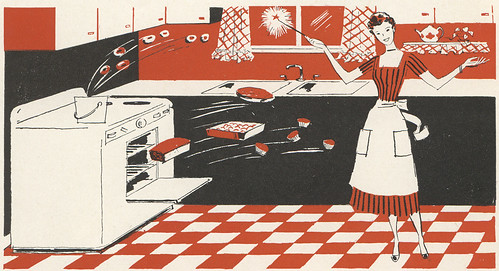
More cookbooks—containing photos, detailed recipes, kitchen instruction, and corporate advertising—poured onto the market during the 1950’s than at any previous time in US history. These cookbooks often served as domestic advice manuals for women; authors would usually include specific directions and advice for women’s cooking and other duties. According to Leavitt, domestic advisors selling such prescriptive rhetoric to women have “always remained engaged in their culture and aware of important issues…they helped educate women about sanitation and design, patriotism, religion, and the family.” The most celebrated domestic advisor/mythical mother figure of the 1950s was the fictional Betty Crocker, who had a best-selling cookbook named after (and “written by”) her.
Betty Crocker's Picture Cook Book "showed just how much home cooks wanted the simply phrased reassurance and reliable advice” they associated with Betty Crocker. Horner posits that the text within the famous cookbook reflects “the cultural preoccupation with women’s roles after the end of World War II.” Through both anecdotal writing and cutesy illustrations (of American folk tales and gender roles being played out), Betty Crocker’s Picture Cook Book linked domestic tasks with the restorative notion of returning to the United States’ humble origins during the postwar search for national renewal. Uniquely American foods and practices are emphasized amongst allusions to early American history—George Washington appears five separate times.
The book alludes to the prevalent themes of sacrifice, regeneration, and women’s responsibility to enact rituals of fertility and appeasement in the wake of the damages of the war and the reintegration of over 11 million U.S. servicemen into domestic life. It specifies the bodily practice of cooking as a traditionally feminine practice important for the maintenance of family life and thus the nation.
From the introduction to the Yeast Bread section:
The memory of a cozy kitchen filled with the warm fragrance of freshly baked bread still means home…today’s homemaker who wants to give her family the cozy comfort of freshly baked bread can make it much more easily and quickly than ever before.
Through the practice of baking bread and making a “cozy” home, the housewife does her part to usher in the rise of a renewed civilization after the war. The text admits that bakeries often offer better baked goods, however the labor, the physical engagement of the woman’s body, that goes into the preparation of the bread is as meaningful to the cozy atmosphere as the warm fragrance itself.
***
Images from the original Betty Crocker's Picture Cook Book
Crocker, Betty, Betty Crocker's Picture Cookbook. (John Wiley & Sons, 1998).
Sources:
Horner, Jennifer R., “Betty Crocker’s Picture Cookbook: A Gendered Ritual Response to Social Crises of the Postwar Era.”
Journal of Communication Inquiry, Vol. 24, No. 3, 2000.
Leavitt, Sarah Abigail, From Catharine Beecher to Martha Stewart. (UNC Press, 2002).
Neuhaus, Jessamyn. “The Way to a Man's Heart: Gender Roles, Domestic Ideology, and Cookbooks in the 1950s.” Journal of
Social History, Vol. 32, 1999
Shapiro, Laura, “"I Guarantee": Betty Crocker and the Woman in the Kitchen,” in From Betty Crocker to feminist food studies:
critical perspectives on women and food, (Liverpool University Press, 2005)



No comments:
Post a Comment